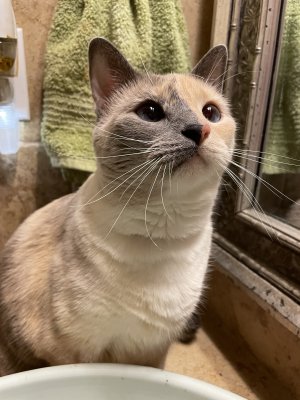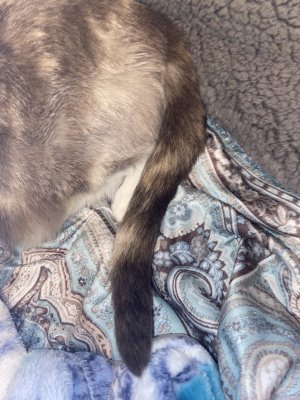- Joined
- Nov 13, 2022
- Messages
- 93
- Purraise
- 154
This summer I rescued two stray kittens from my neighborhood. Several of the stray neighborhood cats exhibit colorpoint patterns, including the one I highly suspect to be the kittens' mother. The suspected mother appears to be a blue lynx point with white mitted paws. I am not sure if the kittens share a father.
The sister (Sydney) of the kitten in question is a seal tortie point with high white spotting (or a non-dilute calico point, if you prefer that terminology). She is pictured as a color reference.
This kitten (Delphi) is the strangest conundrum of color I've ever seen. I have had her genetically tested, and I will provide a list of applicable tested traits and results near the bottom. I have not had the sister tested yet. I am still awaiting her Whole Genome sequence, which may provide additional information when it comes in. I think the test is by a reputable company, because I tested my orange male (not pictured) and got exactly the results I was expecting, so I do think the results are correct barring some weird lab contamination incident.

Her phenotype/what I am visibly seeing, is as follows:

The really weird stuff: her genetic test results:
She is so different in color to her sister, I doubt that difference in shade is entirely due to the agouti gene, but maybe I'm wrong?
Alternately, could she be a chimera, with her test showing as non-dilute when she appears mostly dilute, especially with the irregular patches on her back paws being so much darker than the rest of her markings?
I have studied genetics, but I am fairly new to the world of feline genetics and was wondering if any feline genetic experts or cat color afficionados would like to have a go at seeing what they think is going on with her color.
TLDR: genetic test didn't match what I'm visibly seeing, so looking for possible explanations and opinions. Any breeders who have seen this same effect also welcome to chime in!
Thank you in advance!
I can post additional photos for reference if needed.
The sister (Sydney) of the kitten in question is a seal tortie point with high white spotting (or a non-dilute calico point, if you prefer that terminology). She is pictured as a color reference.
This kitten (Delphi) is the strangest conundrum of color I've ever seen. I have had her genetically tested, and I will provide a list of applicable tested traits and results near the bottom. I have not had the sister tested yet. I am still awaiting her Whole Genome sequence, which may provide additional information when it comes in. I think the test is by a reputable company, because I tested my orange male (not pictured) and got exactly the results I was expecting, so I do think the results are correct barring some weird lab contamination incident.
Her phenotype/what I am visibly seeing, is as follows:
- She is colorpoint and her colors are slightly darkening with age as expected of a colorpoint.
- Her eyes are blue, leaning towards aqua, not nearly as dark as her littermate's blue eyes.
- She has mid-high white spotting, exhibiting white crossing over her pale markings on her back as well as on her paws and extending to part of her face.
- She is a lynx point, showing the expected markings on her face and tail.
- She is patched/calico, showing very faint orange markings on the left side of her face and her left ear, including a small, but bright orange lynx tip on her left ear.
- The weird stuff: Her markings are very faint and pale, except for irregular seal-colored patches on the back of her paws, mostly her hind paws. The stripes on her tail are also a good bit darker than the rest of her markings, but still have a silvery cast between the stripes. On the rest of her body, her "black" areas are soft silvery grey, and the stripes overlaying them are brown, peach, or fawn in color, giving her a "warm stripes on cool background" appearance.
The really weird stuff: her genetic test results:
- She tests negative for any Siamese, Burmese, and Birman (not that surprising, she is a random-bred street cat)
- She tests negative and is NOT a carrier for ALL SIX tested colorpoint alleles.
- (She has a novel mutation that gives her colorpoint??)
- She is a carrier for one Bengal Charcoal coat mutation.
- She is NOT genetically dilute. (She is a carrier)
- She is heterozygous agouti (tabby)
- She is negative and is NOT a carrier for all of the following: Chocolate, Copal, Russet, Amber, Cinnamon, Lykoi, Curly, Sphynx.
She is so different in color to her sister, I doubt that difference in shade is entirely due to the agouti gene, but maybe I'm wrong?
Alternately, could she be a chimera, with her test showing as non-dilute when she appears mostly dilute, especially with the irregular patches on her back paws being so much darker than the rest of her markings?
I have studied genetics, but I am fairly new to the world of feline genetics and was wondering if any feline genetic experts or cat color afficionados would like to have a go at seeing what they think is going on with her color.
TLDR: genetic test didn't match what I'm visibly seeing, so looking for possible explanations and opinions. Any breeders who have seen this same effect also welcome to chime in!
Thank you in advance!
I can post additional photos for reference if needed.



 let us know what the WGS says!
let us know what the WGS says!

